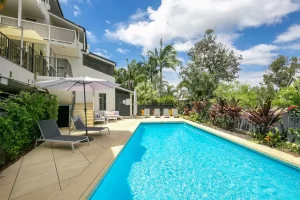Apartments in Noosa Heads and Sunshine Beach have topped the list of the fastest-growing rental markets in the country during the past 12 months to September, with rents soaring by as much as 40 per cent, as tenant demand for homes in lifestyle locations shows no signs of easing up, data from CoreLogic shows.
Across the regions, rents have climbed by 12.5 per cent – the highest annual growth on CoreLogic’s record as the shortage of stock amid high demand pushed rents through the roof.
Nationally, rental rates have jumped by 8.9 per cent year-on-year, the fastest growth in dwelling rents in more than 13 years.
CoreLogic’s research director, Tim Lawless, said a desire for detached housing and lack of supply due to previously historically low levels of investor activity had fuelled the strong rental growth.
Rents for houses in Broome and Cable Beach in Western Australia have surged by 37.7 per cent and 33.3 per cent respectively. Meanwhile, Suffolk Park and Byron Bay in the Richmond-Tweed region of NSW notched 31.6 per cent and 30.4 per cent growth respectively.
In Sydney, Freshwater and Palm Beach recorded the biggest jump in rents in the past year, rising by 24 per cent and 23.1 per cent respectively. Houses there are fetching about $1300 in rent per week.
Houses in Canterbury and Kew in Melbourne’s inner east recorded 10.8 per cent and 9.5 per cent rental growth respectively, while Mount Eliza on the Mornington Peninsula notched a 12.5 per cent rise.
Despite the strong showing in the past year, rental growth had eased slightly during the three months ending September as affordability started to bite, said Mr Lawless.
The national rental index had risen by 1.9 per cent, lower than the 2.1 per cent recorded in the June quarter.
Brisbane and Sydney were the strongest rental markets during the quarter with median rents rising by 2.6 per cent and 2.3 per cent respectively.
Melbourne gained 1.2 per cent, Adelaide and Hobart were up by 1.6 per cent each, Canberra by 1.5 per cent, Darwin by 1.7 per cent and Perth by 0.3 per cent – the slowest across all capitals.
“Rental affordability is becoming more challenging as rents rise at more than seven times the speed of wages, which is probably causing renters to rethink their tenancy options,” said Mr Lawless.
“From a supply perspective, the rise in investor activity would be gradually adding more rental stock to the market.”
Renters return to the cities
While house rents rose at more than double the pace of units rents over the past year, this trend was starting to moderate, with national house and unit rents rising at the same rate of 1.9 per cent over the September quarter, Mr Lawless said.
“I think we are seeing more rental demand being deflected back towards the medium to high density rental markets after demand for higher density rental options dropped through the earlier phase of COVID-19,” he said.
“With rental affordability pressures mounting, it’s logical to assume more renters are willing to look at higher density tenancy options, which in many cases are substantially cheaper than renting a house.”
Across Sydney the difference between renting a house versus a unit is now $166 per week compared with a gap of just $62 per week in March last year.
There are also signs that renters are returning to the cities, with the number of rental listings across inner Sydney normalising to the decade average and Melbourne inner city rental listings only slightly elevated compared with the decade average.
“Clearly rental stock has been absorbed as tenants once again look towards the inner city unit sectors where rents are now much lower than pre-COVID levels,” Mr Lawless said.
“Over the short to medium term we are expecting a further slowdown in rental growth due to worsening affordability and more supply coming on the market.
“However, once international borders re-open, there is likely to be an immediate flow-on effect to rental demand as foreign students and visitors return to Australia. The demand boost from open borders could see additional upwards pressure on rents, especially across the inner-city precincts of Melbourne and Sydney where temporary migrants have historically been a significant component of tenancy demand.”
This article is from Australian Financial Review, please click the following link for the original article: https://www.afr.com/property/residential/strong-demand-and-low-supply-fuel-rent-rises-of-up-to-40pc-20211026-p5935f




